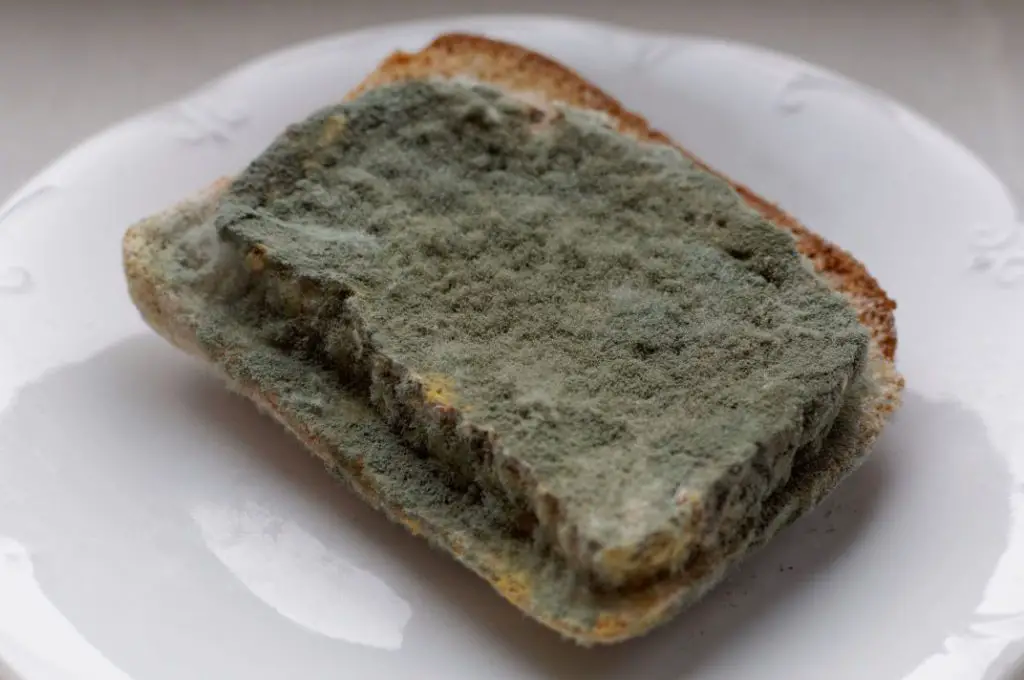Mold on bread is a common occurrence, but what causes it?
The answer is that mold spores exist in the air all around us, and they can find their way into food if they have the right environment in which to grow.
In this blog post, we’ll take a look at what causes mold on bread, the health risks associated with eating it, and how to prevent it from happening in the first place.
Contents
What Causes Mold on Bread?
Mold spores are everywhere – both indoors and outdoors – so it’s no surprise that they often settle on our food. When these spores come into contact with moist surfaces like bread, they germinate and start producing mold.
This mold thrives in warm environments with plenty of moisture; hence why it can so quickly form on fresh-baked loaves of bread or slices of sandwich bread left out for too long.

Mold growth also requires oxygen, so leaving your loaf of bread wrapped up tightly will help prevent mold from forming.
That said, even if you store your bread properly and keep it in an airtight container, eventually the natural yeast present in most types of wheat flour will produce enough carbon dioxide for some mold spores to survive.
The Health Risks Associated With Eating Mold on Bread:
Though some people eat pieces of bread that contain small amounts of visible mold without any adverse effects, ingesting large amounts of mold can be dangerous to your health.
Certain species of mold produce toxins known as mycotoxins which can cause serious illnesses when consumed by humans.
Symptoms can range from nausea to allergic reactions or respiratory problems depending on the type of mycotoxin ingested.
To avoid any potential risk to your health, always discard any food item containing visible amounts of mold.
How To Prevent Mold On Bread?
The best way to prevent mold on bread is to store it properly and consume it within a reasonable amount of time.
1. Storing Bread in Plastic Bags
One popular method of storing bread to prevent mold on bread is to use plastic bags. This is an effective way to keep moisture in and keep air out, ensuring a longer shelf life.
However, some people argue that plastic bags don’t allow the bread to breathe properly.
If you decide to store your bread in plastic bags, be sure not to seal it completely—leave a small opening somewhere near the top of the bag so air can circulate.
2. Storing Bread in Brown Paper Bags
Another popular method of storing bread to prevent mold on bread is using brown paper bags. This allows air to circulate while still keeping moisture in which helps keep the bread from drying out too quickly.
The downside of this method is that it may attract pests like moths or rodents if left out for too long.
To avoid this, be sure to check your paper bag regularly and replace it every week or so if needed.
3. Storing Bread in Linen Bags
For those looking for a more eco-friendly option, linen bags are an excellent choice to prevent mold on bread.
Not only are these breathable and reusable (which means less waste!), but the fabric also absorbs any moisture that might escape from the loaf itself which helps keep it fresh for longer periods of time.
It’s important to note that linen bags should be regularly cleaned with hot water and hung up outside when possible—this will help prevent mold from forming on them over time.
4. Storing Bread in Bread Boxes
Last but not least is the classic way of storing bread—in a bread box! This method keeps air out and prevents mold on bread while also avoiding any potential pests thanks to its lid design.
It’s important to note that if you choose this method, you should wrap your loaf of bread thoroughly so that no crumbs escape into the box—this will help prevent mold from forming inside over time!
Additionally, make sure your box isn’t made of metal; metal could potentially cause rusting which would affect the taste and texture of your loaf when consumed later on down the line!
Can I Store Bread in the Fridge?
Though some people store their bread in the fridge to prevent mold on bread, this is generally not recommended as it can cause the bread to dry out quickly. If you choose to store your bread in the fridge, make sure to use an airtight container or plastic bag with a zipper closure and try to consume it within a week.
Stale bread that’s been stored in the fridge for a long period of time will likely develop mold even more quickly than bread stored at room temperature, so it’s best to use this method only as a last resort.
By understanding what causes mold on bread and taking steps to prevent it from forming, you can ensure that your loaf stays fresh and delicious without putting your health at risk.
Is It Better to Put Bread in the Fridge or on the Counter?
It’s generally best to store bread on the counter to prevent mold on bread unless you plan on consuming it within a day or two. Bread stored at room temperature will last longer than if it were in the refrigerator, as cold temperatures can dry out the loaf too quickly and cause mold to form.
If you’re not planning on eating your loaf for more than a few days, consider freezing it instead.
Freezing will ensure that your bread stays fresh and delicious while also slowing down the growth of any potential mold spores.
It’s important to remember that, no matter where you store your bread, you should always use an airtight container or plastic bag to limit oxygen exposure and slow down yeast activity (which produces CO2). This will help to ensure your bread stays as fresh and mold-free as possible.
Why Does My Bread Mold So Fast?
Bread is susceptible to mold because it contains starch, which is a complex carbohydrate.
When starch breaks down, it releases sugar, which feeds the growth of certain types of fungi called molds. Most molds thrive in warm, humid environments and require oxygen to grow.
That’s why bread stored in a hot, damp atmosphere will usually go bad faster than bread stored in a dry environment with lower temperatures.
How Can You Slow Down Mold Growth on Bread?
The best way to slow down mold growth on your bread is by storing it correctly. The optimal storage temperature for most grains is between 40-50°F (4-10°C).
If you plan on using your loaf within one week of purchase, store the unopened package in a cool place like a cabinet or pantry away from heat sources such as an oven or dishwasher.
Once opened, either eat the entire loaf within two days or store the remainder in an airtight container or resealable plastic bag and freeze for up to three months. Consume frozen loaves within one month after thawing them at room temperature.
Another way to slow down spoilage is by selecting preservative-free products when possible. Many commercial brands contain additives that help extend shelf life but can negatively affect flavor and texture over time. If you’re looking for freshness without any additional ingredients, buy organic alternatives whenever possible!
Conclusion:
Mold doesn’t have to be inevitable when it comes to keeping your favorite loaf fresh!
By understanding what causes mold on bread and taking steps towards proper storage techniques—such as keeping loaves away from heat sources and using airtight containers—you can keep your favorite slices tasting great for weeks instead of days!
No matter what kind of storage material you choose, one thing remains consistent across all methods: allowing air circulation while keeping moisture in will always maximize freshness when storing your favorite loaves of bread!
We hope this guide has been helpful for website owners and bakers alike looking for tips on how best to store their delicious creations! With these tips in mind, we wish everyone good luck on their journey towards achieving maximum freshness every time they enjoy their favorite loaves!
Happy baking everyone!
Amazon and the Amazon logo are trademarks of Amazon.com, Inc, or its affiliates.

